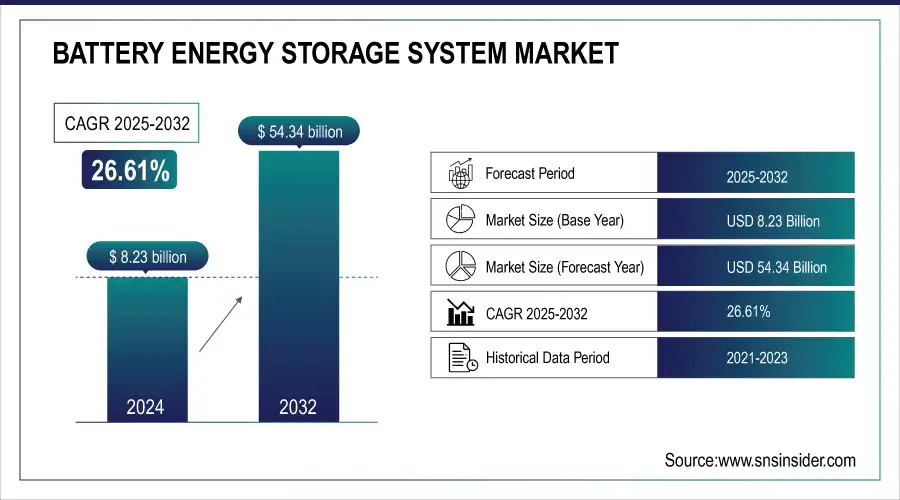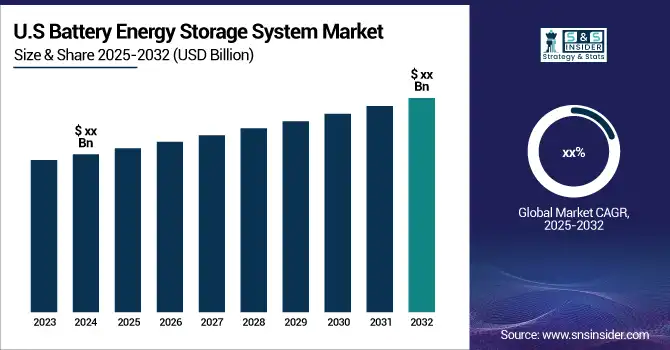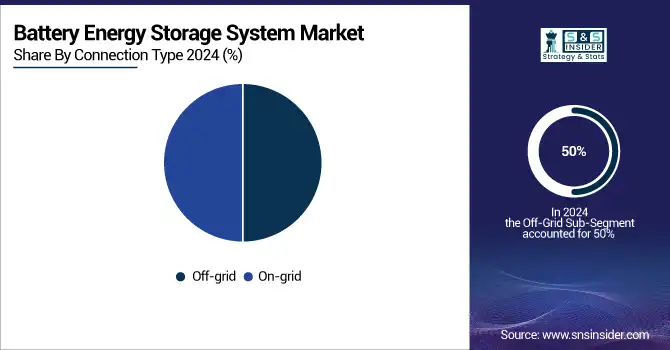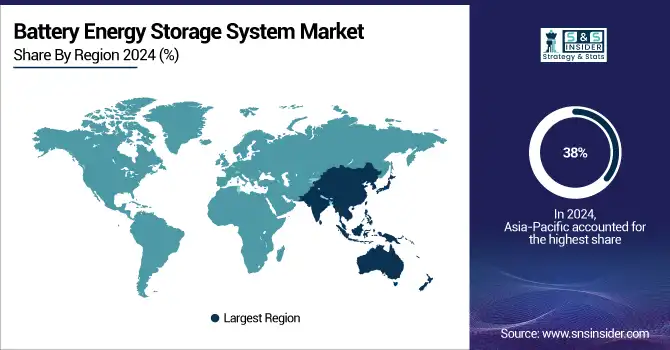Battery Energy Storage System Market Size Analysis:
The Battery Energy Storage System Market size was valued at USD 8.23 Billion in 2025E. It is estimated to reach USD 54.34 Billion by 2033, growing at a CAGR of 26.61% during 2026-2033.
The battery energy storage systems (BESS) market has seen a significant increase in demand in recent years, driven by the increasing focus worldwide on renewable energy, electrification, and the importance of effective energy management. The global shift towards decarbonization and cleaner energy is a major factor driving the BESS market. Nations and sectors are both establishing ambitious goals to decrease carbon emissions, with the storage of renewable energy being essential in reaching these objectives. The U.S. government has introduced numerous important projects to decrease carbon emissions, by its pledge to the Paris Agreement to reduce greenhouse gas emissions by 52% from 2005 levels by 2030. The Infrastructure Investment and Jobs Act (IIJA) and the Inflation Reduction Act (IRA), provide significant funding of around USD 1.2 trillion and USD 369 billion for clean energy initiatives, such as electric vehicle (EV) infrastructure and renewable energy projects.
Battery Energy Storage System (BESS) Market Size and Forecast:
-
Market Size in 2025E: USD 8.23 Billion
-
Market Size by 2033: USD 54.34 Billion
-
CAGR of 26.61% From 2026 to 2033
-
Base Year: 2025
-
Forecast Period: 2026-2033
-
Historical Data: 2022-2024

Get more information on Battery Energy Storage System Market - Request Sample Report
California is working towards achieving 100% clean electricity by the year 2045, whereas New York has set a goal of reaching 70% renewable energy by 2030. Solar and wind energy are inconsistent sources of power, as they do not produce electricity steadily. Battery Energy Storage Systems tackle this restriction by storing energy during peak availability and releasing it during low availability periods. This guarantees the effective utilization of renewable energy and reduces unnecessary waste.
Battery Energy Storage System Market Highlights:
-
Rising need for grid stability and reliable energy supply is driving BESS adoption, as aging infrastructure and supply fluctuations lead to power outages globally.
-
Battery energy storage systems are critical for integrating renewable energy, storing excess production, and supplying energy during high-demand periods.
-
Government initiatives and state-level investments, such as grid modernization projects in the U.S., support BESS deployment to improve resilience and reliability.
-
Falling lithium-ion battery costs (over 80% reduction in the last decade) are increasing affordability and adoption in residential, commercial, and utility-scale applications.
-
Limitations in battery energy density constrain usage in urban areas and large-scale applications, impacting BESS adoption where space or prolonged high output is required.
-
Growing electric vehicle demand increases competition for batteries, potentially raising costs and influencing BESS market dynamics.
The U.S. Battery Energy Storage System (BESS) market size was valued at an estimated USD 3.15 billion in 2025 and is projected to reach USD 20.85 billion by 2033, growing at a CAGR of 24.6% over the forecast period 2026–2033. Market growth is driven by the rapid expansion of renewable energy capacity, particularly solar and wind, and the increasing need for grid stability and energy reliability. Rising investments in utility-scale and residential energy storage projects, coupled with favorable government incentives, tax credits, and supportive energy policies, are accelerating adoption across the country. Technological advancements in lithium-ion batteries, declining battery costs, and growing deployment of smart grid and peak-shaving solutions further support the strong growth outlook of the U.S. BESS market during the forecast period.

Another important factor contributing to the growth of the BESS market is the rising need for grid stability and reliable energy supply. Power outages and instability have occurred due to aging grid infrastructure and fluctuations in energy supply in numerous regions globally. In 2023, the American Society of Civil Engineers (ASCE) predicts that approximately USD 100 billion will be necessary in the next 10 years to improve resilience and decrease outages in the U.S. power infrastructure. Around USD 50 billion has been invested by utilities in transmission and distribution upgrades in recent years, with an emphasis on improving reliability and bringing the systems up to modern standards. In 2022, state-level efforts contributed more than USD 2.7 billion to grid modernization projects, especially in California, New York, and Texas. Battery energy storage systems offer a remedy by stabilizing the grid, regulating frequency, and smoothing the renewable energy output. This feature is especially critical in areas with severe weather or insufficient grid capacity to manage fluctuating electricity demand.
Battery Energy Storage System Market Drivers:
-
The rise of battery energy storage systems in renewable energy integration.
The primary factor driving the growth of the Battery Energy Storage System market is the push for a more sustainable future. As countries work towards meeting climate targets, the use of renewable energy sources has dramatically increased. Yet, the characteristics of these energy sources present difficulties as they are frequently changing and hard to forecast. Solar energy production reaches its highest point during daylight hours, whereas wind energy can be inconsistent. To handle this variability, energy storage systems are crucial. During times of high production, they can save extra energy and then send it out during times when there is less energy being produced or when demand is higher. This ability not only improves grid reliability but also enables a wider embrace of renewable energy sources. The growing quantity of solar farms and wind parks, along with energy storage, could result in a more stable and environmentally friendly energy system.
Moreover, numerous nations are encouraging the use of renewable energy in combination with storage options. As an example, areas with high levels of solar power integration may experience notable advantages from Battery Energy Storage Systems (BESS) because they allow for increased energy self-sufficiency and protection. The increasing consumer interest in sustainability and renewable energy is expected to keep driving demand, playing a key role in the growth of the BESS market.
-
The impact of falling lithium-ion battery costs on residential and commercial applications.
The progress in battery technologies, particularly lithium-ion batteries, has been extraordinary. In the last ten years, the cost of lithium-ion batteries has dropped by over 80%, making them more widely available and cheaper for different uses. The reduction in expenses has changed the financial aspects of storing energy, resulting in a rise in usage for homes and businesses. Reduced battery costs enable businesses and consumers to see a faster ROI. For example, houses that have solar panels are now able to install battery storage units to save extra energy during daylight hours and utilize it in the evening, which helps in efficient energy consumption and reducing electricity costs. Additionally, with the increasing production volumes, the costs are forecasted to decrease even more due to economies of scale, leading to further market expansion. The decreased amount of money needed for BESS investments creates new possibilities for investors, resulting in a broader implementation in various regions and uses.
Battery Energy Storage System Market Restraints:
-
Implications for urban applications and electric vehicle growth.
Energy density is the quantity of energy stored in a specific space, and existing battery technologies have restrictions in this area. Although lithium-ion batteries are commonly used in BESS, their energy density may restrict their usage, particularly in urban areas where space is scarce. Limitations in capacity can present significant challenges in applications that require prolonged high-energy output. For example, businesses or factories may need large energy storage systems to maintain operations during power failures or high usage periods. If BESS fails to meet these needs adequately, users might look into other storage options with higher capacity. Furthermore, with the rising number of electric vehicles being used, the demand for energy storage space also grows. The increasing need for batteries can put pressure on their availability and cause prices to rise, which in turn complicates market dynamics and hinders the adoption of BESS.
Battery Energy Storage System Market Segment Analysis:
By Connection Type
The off-grid sector dominated in 2025 with over 50% market share, especially in distant and countryside regions with no dependable grid connection. Off-grid systems increase energy self-sufficiency by storing renewable energy for later use, cutting energy expenses, and improving dependability. These systems play a key role in telecommunications, remote mining operations, and emergency backup solutions. For instance, Sungrow provides off-grid energy solutions that enable remote communities to utilize solar power for essential requirements.
The on-grid sector is going to experience a rapid growth rate during 2026-2033, due to the rising need for renewable energy incorporation and grid reliability. On-grid systems are linked to the electrical grid, enabling users to save extra energy produced from renewable sources like solar and wind. This energy stored can be utilized during times of high demand, increasing efficiency and decreasing dependence on fossil fuels. Tesla, among other companies, created the Tesla Powerwall to allow homeowners to save energy for future use and help support grid functions.

By Battery
Lithium-ion batteries held a market share of 35% in 2025 because of their powerful energy storage capacity, effectiveness, and decreasing prices. They have many uses across different fields, including consumer electronics, electric vehicles, and large-scale energy storage systems. Tesla and similar companies use lithium-ion technology in their Powerwall and Powerpack systems to improve energy independence and reliability in residential and commercial energy storage solutions.
Flow batteries are to experience the fastest CAGR during 2026-2033, mostly because of their scalability, extended cycle life, and capacity to store significant energy quantities. These batteries are especially appropriate for tasks that involve storing energy for a long period, like managing energy on a grid level and integrating renewable energy. Redflow and other companies are advancing in this field by developing zinc-bromine flow batteries suitable for residential and commercial applications.
By Application
The residential sector held a market share of more than 41% in 2025 and led the market, due to the rising popularity of renewable energy sources like solar panels. Homeowners are purchasing battery storage systems to maximize energy usage, decrease electric bills, and guarantee emergency power during blackouts. These systems enable users to save extra energy produced during the day for use during the night, which improves energy self-sufficiency. Tesla and Sonnen showcase advancements in the industry by providing customizable and efficient solutions for homeowners through products like the Powerwall and ecoLinx system.
The commercial sector is to become the fastest-growing market during 2026-2033. Businesses are more and more utilizing battery storage systems to control peak demand charges, enhance energy efficiency, and guarantee dependable backup power. This portion includes various uses, such as office buildings, retail areas, and industrial sites. Fluence and LG Chem are leading the way by offering solutions for businesses to incorporate renewable energy sources and improve their operational resilience on a large scale.
Battery Energy Storage System Market Regional Analysis:
Asia-Pacific Battery Energy Storage System Market Trends:
The APAC region dominated the market in 2025 with a 38% market share because of fast industrial growth and urban development. Nations such as China, Japan, and India are making substantial investments in energy storage options to improve grid reliability and incorporate renewable energy sources. China is at the forefront with key players such as CATL and BYD, who are making progress in lithium-ion battery technologies for big storage projects. Japan's dedication to energy security after Fukushima has led to advancements in battery storage systems, with companies such as Panasonic making significant contributions.

Need any customization research on Battery Energy Storage System Market - Enquiry Now
North America Battery Energy Storage System Market Trends:
North America is accounted to have the fastest growth rate during 2026-2033, fueled by rising investments in renewable energy sources and favorable government policies. Tesla and Fluence are leading the way in growth by providing advanced energy storage solutions like the Powerwall and utility-scale systems. The increasing demand for dependable energy storage to maintain a balance between supply and demand, especially in California and Texas, continues to drive market growth.
Europe Battery Energy Storage System Market Trends:
Europe holds a significant share of the market due to ambitious renewable energy targets and decarbonization policies. Germany, the UK, and France are heavily investing in grid-scale storage and residential battery solutions. Companies such as Siemens Energy and ABB are advancing energy storage technologies to support the region’s transition to a low-carbon economy. Government incentives and initiatives for smart grids are also accelerating adoption.
Latin America Battery Energy Storage System Market Trends:
Latin America is witnessing steady growth, driven by the increasing adoption of renewable energy sources in Brazil, Chile, and Mexico. Companies are focusing on grid stability and off-grid energy solutions to address fluctuating supply. Government incentives and partnerships with global energy storage providers are contributing to market development.
Middle East & Africa Battery Energy Storage System Market Trends:
The Middle East and Africa region is gradually expanding its energy storage market, focusing on renewable energy integration in countries such as UAE, Saudi Arabia, and South Africa. Projects combining solar power with battery storage are becoming common, supported by government investments and sustainability initiatives. Local and international companies are collaborating to deploy utility-scale and off-grid storage solutions.
Top 20 Battery Energy Storage System (BESS) Companies are:
-
Tesla (Powerwall, Powerpack)
-
LG Energy Solution (RESU, E-House Solutions)
-
Samsung SDI (Energy Storage Systems, Lithium-ion Battery Packs)
-
Panasonic (Tesla Gigafactory Batteries, Residential Energy Storage Systems)
-
Siemens (Siemens SIESTORAGE, Siestorage Advanced Battery Storage)
-
GE Renewable Energy (Reservoir, Grid Solutions)
-
Fluence (Advancion, SunFlex Energy Storage)
-
ABB (ABB Ability Energy Storage, ABB PowerStore)
-
Honeywell (Honeywell Energy Storage, GridFlex)
-
Schneider Electric (EcoBlade, Conext Core XC)
-
BYD (BYD B-Box, BYD Energy Storage System)
-
Saft (IntelliHedge, Lithium-ion Battery Solutions)
-
JinkoSolar (Jinko Smart Storage, JinkoEnergy Storage)
-
Eaton (Energy Storage System, Eaton xStorage)
-
VARTA (VARTA pulse, VARTA Storage)
-
NGK Insulators (NAS Battery System, NAS Battery Modules)
-
CATL (Energy Storage System, Lithium-ion Battery Pack)
-
Duracell (Duracell PowerSource, Duracell Portable Power)
-
Kraftpowercon (Kraftpowercon Energy Storage, Hybrid Energy Solutions)
-
Engie (Engie Storage Solutions, Engie Grid Storage)
Battery Energy Storage System Market Competitive Landscape:
TotalEnergies, established in 1924, is a global energy company engaged in oil, natural gas, renewables, and electricity. The company focuses on developing sustainable energy solutions, including battery storage and solar projects, to support the transition to a low-carbon economy while expanding its footprint in energy storage systems and grid integration worldwide.
-
TotalEnergies launched a 100 MW/200 MWh battery storage project with Kyon Energy and Saft, an affiliate of TotalEnergies in North Rhine-Westphalia, Germany, which is a significant step in the direction of Germany’s decarbonization, since the project started in July 2024.
Tesla, founded in 2003, is a leading electric vehicle and clean energy company headquartered in the U.S. The company develops advanced energy storage solutions, including residential and utility-scale systems, to support renewable energy integration. Tesla’s innovations in batteries and sustainable technologies drive global adoption of clean energy solutions.
-
Tesla had a significant increase in the capacity of its battery storage systems in August 2024, as ERCOT cleared 480 MW for commercial use at Tesla’s Texas Gigafactory.
EDP Renewables, established in 2007, is a global leader in renewable energy, headquartered in Portugal. The company specializes in wind and solar power generation and develops energy storage solutions to enhance grid stability. EDP Renewables focuses on sustainable energy projects worldwide, supporting the transition to a low-carbon economy through innovation and clean technology.
-
EDP Renewables in collaboration with Dominion Energy started an 85 MW/340 MWh battery energy storage system in Virginia, sealed in September 2024.
Mitsubishi Power, established in 1921, is a global energy solutions provider headquartered in Japan. The company specializes in power generation technologies, including gas, steam, and renewable energy systems. Mitsubishi Power develops advanced energy storage solutions and grid integration technologies, supporting reliable, efficient, and sustainable energy supply worldwide.
-
Mitsubishi Power announced in April 2023 the completion of a 200 MWh BESS project in California which is used for stabilizing the grid and facilitating higher integration of renewable energy.
AES Corporation, founded in 1981 and headquartered in the U.S., is a global energy company specializing in power generation and distribution. The company focuses on renewable energy, including solar and wind, and develops advanced energy storage solutions to enhance grid reliability, support decarbonization, and promote sustainable energy transition worldwide.
-
AES Corporation started a 112 MW/560 MWh battery energy storage system in Chile, accelerating this country to become one of the first decarbonized economies of South America, as it was presented in July 2023.
| Report Attributes | Details |
|---|---|
| Market Size in 2025E | USD 8.23 Billion |
| Market Size by 2033 | USD 54.34 Billion |
| CAGR | CAGR of 26.61% From 2026 to 2033 |
| Base Year | 2025 |
| Forecast Period | 2026-2033 |
| Historical Data | 2022-2024 |
| Report Scope & Coverage | Market Size, Segments Analysis, Competitive Landscape, Regional Analysis, DROC & SWOT Analysis, Forecast Outlook |
| Key Segments | • By Battery (Lithium-Ion Batteries, Advanced Lead-Acid Batteries, Flow Batteries, Others) • By Connection Type (On-grid, Off-grid) • By Ownership (Customer-Owned, Third-Party Owned, Utility-Owned) • By Energy Capacity (Below 100 MWh, Between 100 to 500 MWh, Above 500 MWh) • By Application (Residential, Commercial, Utility) |
| Regional Analysis/Coverage | North America (US, Canada), Europe (Germany, UK, France, Italy, Spain, Russia, Poland, Rest of Europe), Asia Pacific (China, India, Japan, South Korea, Australia, ASEAN Countries, Rest of Asia Pacific), Middle East & Africa (UAE, Saudi Arabia, Qatar, South Africa, Rest of Middle East & Africa), Latin America (Brazil, Argentina, Mexico, Colombia, Rest of Latin America). |
| Company Profiles | Tesla, LG Energy Solution, Samsung SDI, Panasonic, Siemens, GE Renewable Energy, Fluence, ABB, Honeywell, Schneider Electric, BYD, Saft, JinkoSolar, Eaton, VARTA, NGK Insulators, CATL, Duracell, Kraftpowercon, Engie |

